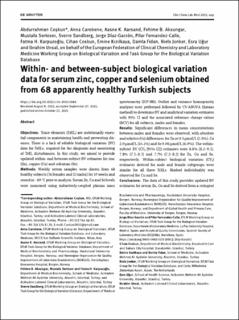| dc.description.abstract | Objectives: Trace elements (TrEL) are nutritionally essential components in maintaining health and preventing diseases. There is a lack of reliable biological variation (BV) data for TrELs, required for the diagnosis and monitoring of TrEL disturbances. In this study, we aimed to provide updated within- and between-subject BV estimates for zinc (Zn), copper (Cu) and selenium (Se).
Methods: Weekly serum samples were drawn from 68 healthy subjects (36 females and 32 males) for 10 weeks and stored at −80 °C prior to analysis. Serum Zn, Cu and Se levels were measured using inductively-coupled plasma mass spectrometry (ICP-MS). Outlier and variance homogeneity analyses were performed followed by CV-ANOVA (Røraas method) to determine BV and analytical variation estimates with 95% CI and the associated reference change values (RCV) for all subjects, males and females.
Results: Significant differences in mean concentrations between males and females were observed, with absolute and relative (%) differences for Zn at 0.5 μmol/L (3.5%), Cu 2.0 μmol/L (14.1%) and Se 0.06 μmol/L (6.0%). The within-subject BV (CVI [95% CI]) estimates were 8.8% (8.2–9.3), 7.8% (7.3–8.3) and 7.7% (7.2–8.2) for Zn, Cu and Se, respectively. Within-subject biological variation (CVI) estimates derived for male and female subgroups were similar for all three TrELs. Marked individuality was observed for Cu and Se.
Conclusions: The data of this study provides updated BV estimates for serum Zn, Cu and Se derived from a stringent protocol and state of the art methodologies. Furthermore, Cu and Se display marked individuality, highlighting that population based reference limits should not be used in the monitoring of patients. | en_US |
